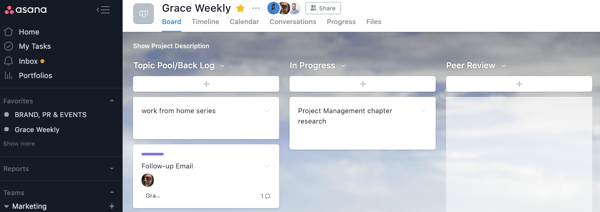October 23, 2018
 by Grace Pinegar / October 23, 2018
by Grace Pinegar / October 23, 2018

I have never done well in an obstacle course.
The idea of having to accomplish so many varying activities in such a short span of time — while racing against other children and their superiority complexes — has always sent me into an endless spiral of anxiety.
Climbing walls? I’d pass out before I’d pass over.
Monkey bars? These hands weren’t made to blister.
Tight-rope walking? Not unless I’m watching it, from my seat, at the circus.
You get the point: I’m bad at things.
Managing multiple projects at once can often feel like an obstacle course. If you relate to what I’ve said above, this is not an attractive comparison.
For project management professionals, however, this is just the truth of the job. Your team is running in 18 different directions and you are expected to keep up the pace.
This is especially true during busy seasons, which vary depending on your industry. If you’re a retail employee or manager, holidays are a time to multi-task. If you work in sales, the end of the fiscal year might all-around feel like misery on a plate.
Regardless of a person’s particular role at a company, we could all benefit from better understanding how to keep multiple plates spinning.
It’s important to know how to manage multiple projects well so you can maintain quality across assignments. When you hand work to a manager, they unfortunately don’t see the number of things you had on your plate. They see what you put before them.
For this reason, you’ll want to give everything 100 percent; or at least make it look like you were able to give everything 100 percent. Oddly enough, it has been proven that we cannot do it all.
If you’re struggling to stay on top of shifting priorities, allow these tips to help you realign strategies and complete everything as if it’s your one and only.
This sounds counterproductive as this entire article centers around how to successfully manage multiple projects at once. However, studies show that multi-tasking is actually not as productive as you think it is.
When we split our focus, our brains actually give less attention to each task than they would were we to focus fully on one thing at a time.
This sentence sounds confusing. To clarify, understand that you can’t possibly commit 100 percent of your attention to two separate things. Let go of the idea of doing two things at once, and instead embrace the idea that it’s better to give one thing your full attention. In short, work smarter, not harder.
One of the best things you can do for yourself as a person with a hefty to-do list is to plan ahead. Instead of flying by the seat of your pants, spend each morning carefully evaluating what you need to accomplish that day.
Spend every Monday carefully evaluating what needs to be accomplished that week. Organize your tasks with labels such as due dates and importance. This will help you prioritize and better understand what needs to be completed within specific timeframes.

Have all of your tasks laid out so you know what’s left to do. Projects are made up of many small steps, and it’s important you know what all is on your list before you set out to attack it.
One key to staying above water when you’re working on a multitude of projects is remaining organized. How do you plan on having a productive workday if your calendar is outdated, your notebook is falling apart, and your inbox is overflowing with emails you’re too stressed to check up on?
Following some simple organizational tactics will nip these insecurities in the bud. For one, be sure to write out and keep that to-do list we’ve spoken so much about. For many, visualizing tasks via a list or chart is a key factor in getting everything done.
Keep a clean workspace. Buy an organizer for your papers, pens, paperclips, etc. Knowing where to find things will be a huge help when your boss asks for that invoice you printed out weeks ago. Stay on top of your email, even if that means setting aside 20 minutes each morning and evening to clear everything out.
Backlogged communication is a huge stress point for me, and I’m sure you’d feel better if you assigned a little bit of each day to tackling your inbox.
Setting and understanding expectations is a huge part of managing multiple projects at once. You need to know what everyone is expecting in order to deliver the quality product or service you’ve promised.
Expectations will look different depending on your role and industry. Being that I’m a writer, clarifying expectations would mean asking my manager or editor how many words my assignments should be, or asking questions about an article’s topic.

By asking these questions, I am able to determine where my finish line is. I’m also able to determine what kind of an article would check off all of my editor’s boxes. Asking these questions beforehand helps prevent a misunderstanding that might result in lackluster performance. Be sure to set expectations prior to beginning your projects.
This could mean asking for a checklist, or creating the checklist yourself so as to show management you went above and beyond what was asked of you. No matter how you go about holding yourself accountable to a standard, just be sure that you do. At the end of the day, it’s important that you did the best work you could with your abilities and time.
Communication is an issue at many, if not most, organizations. We simply haven’t cracked the code of how to get dozens of colleagues with various personalities and working styles to openly and transparently say what they think, feel, and need.
In the case of juggling multiple projects, you’ll likely have to assert yourself and ask other people what they think, feel and need. One big example is communicating what’s important. Say you’re an accountant and your CFO has dropped a time-sensitive assignment on you the same week expense reports are due.

In this case, you have to determine what’s more important of the two. Luckily, you don’t have to do that alone. Simply asking your CFO which task is a higher priority can help clear up a lot of your stress and allow you to get to work on what’s more important.
Communication of this kind is helpful across the board. Instead of being afraid of the answer, or fearing that your boss will judge you for asking the question, learn to be an over-communicator. Over-communicators are rarely confused as to which direction they’re going.
| Related: Check out these seven workplace innovation strategies that will help you to grow your business. |
It’s natural to want to help your team out when they ask. We hear our colleagues praised for this kind of behavior all the time, “John was so helpful during our contract emergency last week, dropping everything to get us back on track with a client and make the sale.”
Everyone loves a helper, right? While that’s true, it’s not always within your abilities to be the knight in shining armor. You have a job to do and it comes complete with its own to-do list, expectations, and consequences should you fall short. When you’re trying to master multiple tasks, it’s okay, and even encouraged, to say no to a few things here and there.
You have to protect your time and your standing within the organization, which you do by completing your work consistently. Only you know what extra work you can take on without compromising that. So, don’t be afraid to say no to things that you know will keep you from accomplishing your own goals. While it’s good to be a team player, it’s vital you know when to say when.
Similar to eliminating the phrase “multi-tasking” from your memory, part of juggling multiple projects is learning how to focus well and zero-in on one thing at a time.
We live in an incredibly hectic time period with app notifications, Slack messages, emails, calls from Mom, and more piling in minute by minute. If you’re having trouble with your workload, it could be because you’re too distracted. I advise you to pick one task and put everything else away. Maybe even set a timer for 30-45 minutes and focus on your chosen assignment completely for that amount of time.

You’ll be amazed at what you can accomplish when you’re completely paying attention. Additionally, it may make sense for you to spend some time researching other project management tips on time management. We waste hours every day by simply navigating back and forth from one attention sucker to another.
To start, I suggest taking a look at our article on time management. In this piece, you’ll find information on how to identify and eliminate your main time-wasters, as well as information on how to build a productive team.
Does anything feel better than crossing tasks off of your to-do list? When juggling multiple projects, sources recommend you finish at least one actionable item per day. It’s important that by the time you clock out, you have at least one thing to show for your day at the office.
This doesn’t have to be huge, although it does feel better to cross off something significant. It could be enough to cross off one aspect of a project, so long as you’re able to visualize your progress. Listing out and accomplishing little things can help make large goals feel manageable.
This is also important because it allows you to show others what you’ve accomplished. If your team has weekly meetings where each employee provides an update on their part of the project, having a few things crossed off your list will serve to show management your hard work and dedication.
Project management software can be a life-saver for those who are in the midst of multiple projects at once. Project management software has calendaring tools to help with the scheduling of tasks and subtasks and increases transparency into how other team members are performing.
Additionally, these tools can create daily or weekly reports that provide an overview of team or individual progress. This takes a lot of the manual labor out of managing your schedule and your tasks. Some solutions even have digital to-do lists that allow you to check items off as they are completed.

Those interested could even use software solutions for resource management. Examples of this are meeting room scheduling solutions, or reminders to order pertinent supplies after they’ve run out.
Project management software isn’t just for project managers; it’s for the whole team. It’s an organizational tool meant to help employees visualize their tasks in a digestible way.
They’re also fairly easy to use — depending on how much training you offer employees — and can really change the way you and your team operate.
There are even many free project management software options for teams to explore.
One underrated way to help you manage multiple projects at once is with the help of your team. Think about it. You are all working together to achieve the same goal, albeit with different roles and strengths.
Who better to keep each other on track than the team who also wants to defeat the same challenges? Team accountability can look like team-wide meetings, small group get-togethers, or one-on-one meetings between employee and manager.
These meetings can consist of a detailed listing of everything an employee is working on that week, or it can be a quick two-sentence writeup thrown in a Slack channel.
Accountability keeps you honest. When you know your colleagues are invested in your progress, you’re much less likely to dilly dally and waste time on distractions or other things that don’t matter. Consistent updates encourage you and your colleagues to do consistent work.
Not everything can be the most important thing on your to-do list. That’s where prioritization comes in. It can be tough to know what comes first. Along with communicating and asking management where they’d like you to put your focus, there are some prioritization methods you can work out all on your own.

Some of these methods include color or number-coding tasks by a certain level of importance. You create a number or color key that defines the meaning of each ranking, and then assign tasks a level of importance. This helps you view your priorities as a more quantitative measurement as opposed to a sentiment.
If you’re lacking the skills to properly prioritize your work, or you’d simply like to read more on how to rank tasks, check out our article on how to prioritize at work.
Being that I had two sisters, I was constantly doodling new “Please Knock: Or Else” signs to stick up on my bedroom door. I hated the idea of being disrupted as I was writing in my diary or watching a Full House rerun.
If you or your team is having trouble managing a full calendar, consider investing in a physical signal that your team is not to be disturbed. This can look different for different people. For some, this simply means blocking off time on their Google calendar for a few hours each day that says, “Busy,” or “Please come back later.”
For other teams, this may mean purchasing physical signs or flags that team members can raise when they’d like to be left alone. Although it’s nice to make yourself available as a teammate, it’s also nice to accomplish the goals necessary for everyone’s success.
Again, don’t be afraid to tell your team that it’s not a good time to talk, but you’d be happy to circle back later.
Delegating is difficult for many people because it can feel a lot like passing your work onto others. When done correctly, however, delegating is simply a form of splitting up a team’s efforts so more people can accomplish tasks in less time.
If you’re having trouble doing everything you need to, consider delegating the tasks to those around you. This is, of course, only possible if your colleagues are equipped to help. It should also be approved by a manager, as it’s never an employee’s place to pass their responsibilities on to someone else without approval.

If you’re struggling, try and decipher if delegation is an option for you. Don’t be afraid to ask your manager for help in this. Delegating isn’t a sign of weakness, it just means you have too much on your plate at this current moment in time. It’s a good sign of character that you know when to say when and ask your team to come in for backup.
Work worth doing, and work done well, should make you feel as though you’ve exerted a massive amount of energy into something important. But it shouldn’t feel like that every day.
There’s a reason obstacle courses only come around every so often: many of us could not maintain that type of energy day in and day out. And neither can you do so in the workplace.
By following the aforementioned advice, you should be able get a better handle on your multitude of projects. This will require some evaluation and tweaking so as to eliminate the strategies that aren’t doing you any favors.
It’s impossible to be perfect, and you’ll always have those days or weeks where it just doesn’t feel like it can all get done. And some days it really can’t all get done. In that scenario, it’s important to have patience with yourself, to go home and recharge, and try again with vigor the next day.
If you can do that, then you’re already winning the obstacle course in my book.
Stay tuned for even more project management tips and helpful content!
Ready to take your project management to the next level? Learn how to develop and implement a project scope statement to increase your teams productivity, and learn about the project life cycle.
Grace Pinegar is a lifelong storyteller with an extensive background in various forms such as acting, journalism, improv, research, and content marketing. She was raised in Texas, educated in Missouri, worked in Chicago, and is now a proud New Yorker. (she/her/hers)
They say there are two ways to skin a cat (ew), and there are even more ways to manage a...
 by Grace Pinegar
by Grace Pinegar
Being a project manager involves more than managing projects.
 by Peter Giffen
by Peter Giffen
A portfolio is a collection of your best work, put forth in the hopes of making a positive...
 by Grace Pinegar
by Grace Pinegar
They say there are two ways to skin a cat (ew), and there are even more ways to manage a...
 by Grace Pinegar
by Grace Pinegar
Being a project manager involves more than managing projects.
 by Peter Giffen
by Peter Giffen


